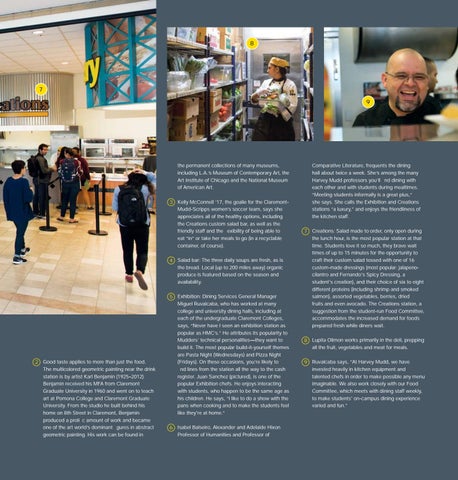8
7 9
the permanent collections of many museums, including L.A.’s Museum of Contemporary Art, the Art Institute of Chicago and the National Museum of American Art. elly McConnell ’17, the goalie for the Claremont3 K Mudd-Scripps women’s soccer team, says she appreciates all of the healthy options, including the Creations custom salad bar, as well as the friendly staff and the flexibility of being able to eat “in” or take her meals to go (in a recyclable container, of course). alad bar: The three daily soups are fresh, as is 4 S the bread. Local (up to 200 miles away) organic produce is featured based on the season and availability.
ood taste applies to more than just the food. 2 G The multicolored geometric painting near the drink station is by artist Karl Benjamin (1925–2012). Benjamin received his MFA from Claremont Graduate University in 1960 and went on to teach art at Pomona College and Claremont Graduate University. From the studio he built behind his home on 8th Street in Claremont, Benjamin produced a prolific amount of work and became one of the art world’s dominant figures in abstract geometric painting. His work can be found in
xhibition: Dining Services General Manager 5 E Miguel Ruvalcaba, who has worked at many college and university dining halls, including at each of the undergraduate Claremont Colleges, says, “Never have I seen an exhibition station as popular as HMC’s.” He attributes its popularity to Mudders’ technical personalities—they want to build it. The most popular build-it-yourself themes are Pasta Night (Wednesdays) and Pizza Night (Fridays). On these occasions, you’re likely to find lines from the station all the way to the cash register. Juan Sanchez (pictured), is one of the popular Exhibition chefs. He enjoys interacting with students, who happen to be the same age as his children. He says, “I like to do a show with the pans when cooking and to make the students feel like they're at home.” 6 I sabel Balseiro, Alexander and Adelaide Hixon Professor of Humanities and Professor of
Comparative Literature, frequents the dining hall about twice a week. She’s among the many Harvey Mudd professors you’ll find dining with each other and with students during mealtimes. “Meeting students informally is a great plus,” she says. She calls the Exhibition and Creations stations “a luxury,” and enjoys the friendliness of the kitchen staff. reations: Salad made to order, only open during 7 C the lunch hour, is the most popular station at that time. Students love it so much, they brave wait times of up to 15 minutes for the opportunity to craft their custom salad tossed with one of 16 custom-made dressings (most popular: jalapenocilantro and Fernando's Spicy Dressing, a student's creation), and their choice of six to eight different proteins (including shrimp and smoked salmon), assorted vegetables, berries, dried fruits and even avocado. The Creations station, a suggestion from the student-run Food Committee, accommodates the increased demand for foods prepared fresh while diners wait. 8 Lupita Olimon works primarily in the deli, prepping all the fruit, vegetables and meat for meals. 9 Ruvalcaba says, “At Harvey Mudd, we have invested heavily in kitchen equipment and talented chefs in order to make possible any menu imaginable. We also work closely with our Food Committee, which meets with dining staff weekly, to make students' on-campus dining experience varied and fun.”
